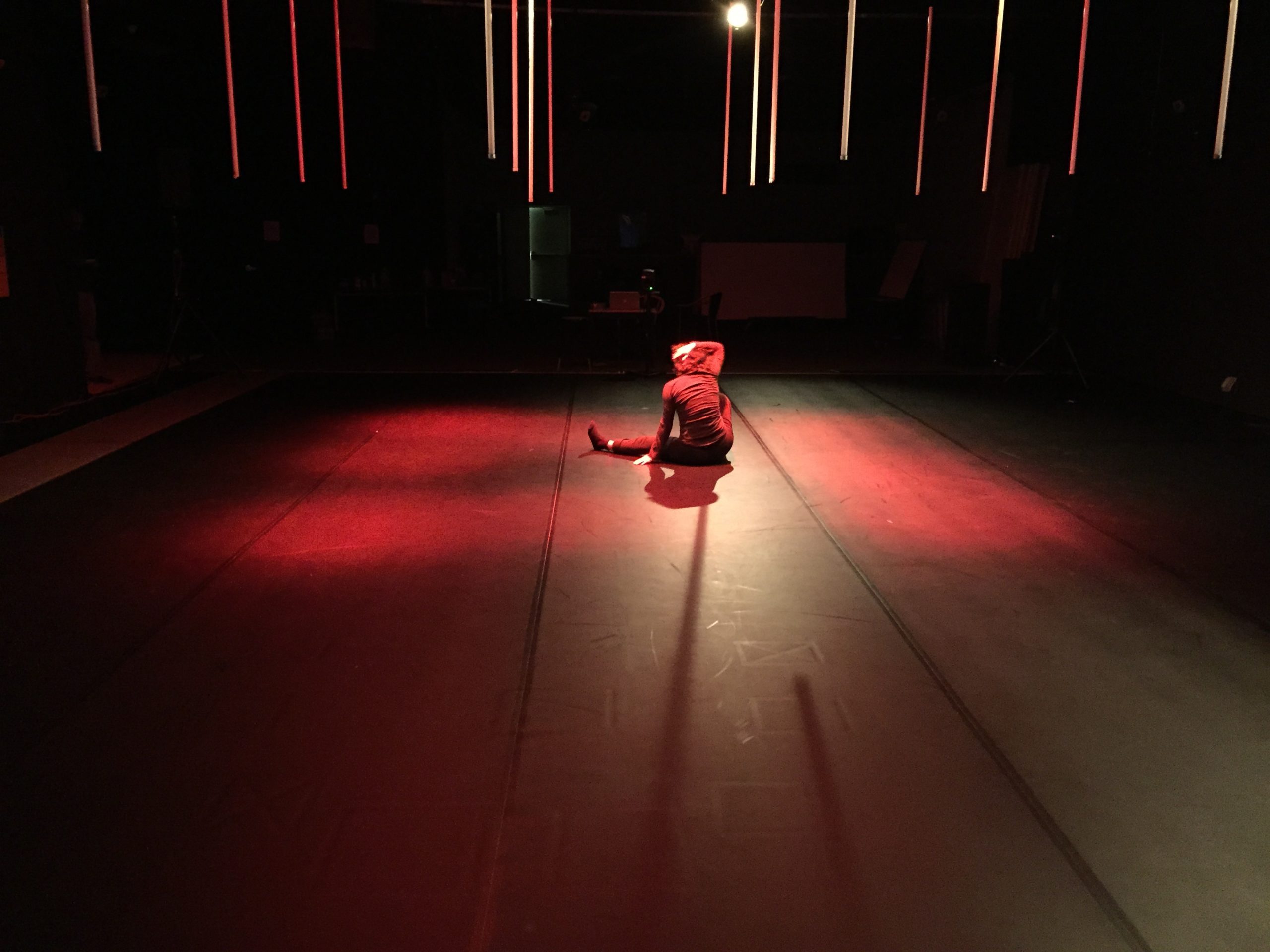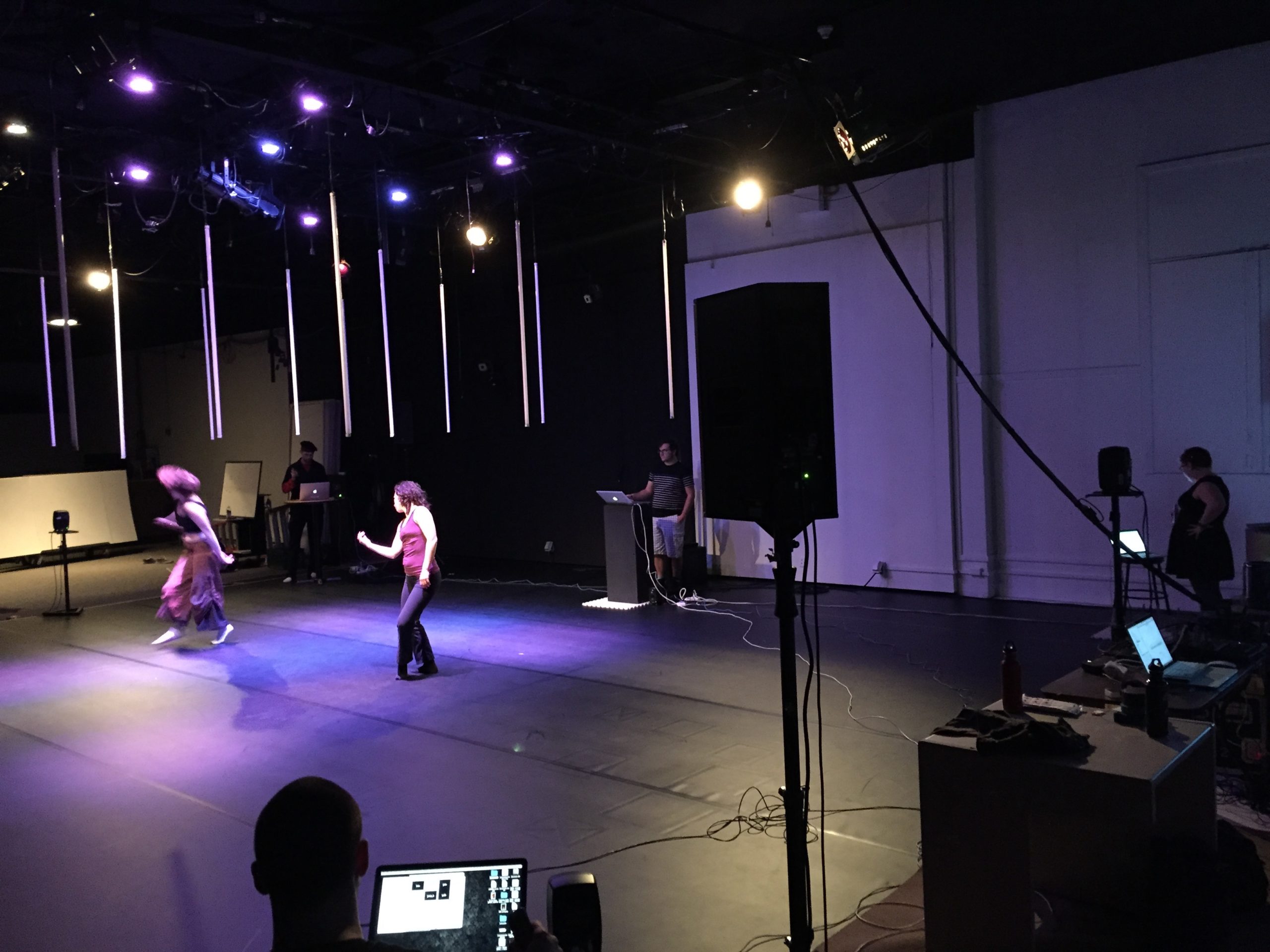On tuning the heart, relationally, with biofeedback.
Overview
Building from our initial studies regarding the ability to choreograph – and reproduce – intentional shifts in the heart activity of dancers over time, we turned to the development of training tools involving biofeedback from electrocardiograms (ECGs) in real-time. Ongoing artistic experiments in this project have been designed to examine potential for interoception (sensing the physiological condition of the body), enaction (an immediacy of action and cognition) and entrainment (processes of non-causal attunement and flow between phenomena). Through this research, we seek to ground our creative practice with a fundamental understanding of embodiment as entangled and inseparable from biology, behaviour and context.
In this section we discuss:
- Guiding principles that emerged via our artistic research, with regard to bodies, biosensors, and mediated environments;
- A series of “tuning experiments“, performed by dancers with biofeedback from ECGs, exploring how to hone a felt sense of relational shifts in physiology, behaviour, and environment; and
- Performance Study 2 for dancer with ECG, percussionist, and live electronics, examining temporal tensions between the musical score and heart rate model as prescribed, versus realized, such that performers must negotiate between plan and live action together.and shared.
Guiding Principles
In the early years of our collaboration, around 2014-2016, we outlined a set of guiding principles regarding encounters of bodies and biosensors, which resonate in our work to present day. In our article From Representation to Relationality: Bodies, Biosensors, and Mediated Environments, these principles are summarized as follows:
- It is impossible for the human body to be measured in its entirety, no matter how many biosensors are used. This is not due to a shortcoming in the biosensor technologies, but rather, it is because there exists no stable, complete body to be measured in the first place.
- Bodies are in continual becoming, through co-articulations and modulations across physiology, behaviour and context; these complex systems of relationality will always, necessarily, exceed representation.
- Biosensor data must be understood as meditated by aspects of the hardware and software tools, as well as the network with which it is recorded. Thus, biodata is never only a result of biology, but rather carries traces of the system design from which it derived.
- Analysis of biosensor data, especially in relation to body, behaviour and context, requires interpretation and imagination on the part of the designers, users and observers.
It is within this interpretive and imaginative space – between bodies, biosensors and networks – that our collaborative research and creation has evolved.
Tuning Experiments
During an Artistic Research Residency at the Synthesis Centre at Arizona State University in Winter 2015, we began to explore practices to cultivate interoception (sensing the internal processes of the body, including heart rate), and entrainment (aligning one’s temporality with an external process) – in this case, with biofeedback from an ECG. Through structured improvisation, we explored the potential of biofeedback during movement and breath improvisations, in order to help performers tune their bodily state with a target in the mediated environment. In these experiments, the dancers received two types of biofeedback: First, ECG data was sonified as musical pitch in a modulating sine tone, which the dancer attempted to match with a pulsing, reference tone; Secondly, heart rate was visualized in the color of the lights, which became increasingly blue below target heart rate, increasingly red above target, and white on-point. The target heart rate may remain fixed, jump periodically, or oscillate smoothly over time as the dancer attempts to follow.
We also explored partner improvisations, during which the target heart rate was derived from the ECG data of a second performer. In this scenario, the two dancers attempted to tune their heart rates with one another through shared movement, breathing, eye contact, touch, and more. Our approach to tuning relates to the notion of entrainment, in that it embraces a non-causal attunement between multiple, modulating entities.
An important aspect of these studies is to explore ways in which each performer can hone a felt sense of what it is like to maintain his/her heart rate at a chosen level—taking into consideration reciprocal relations of heart rate to breath, movement, and environment—as well as if s/he can enact shifts in these temporal relationships over time, with or without biofeedback. We understand our biofeedback system as a form of embodied training, through which each performer may build kinesthetic awareness and agency to navigate between the rhythmic activity of the heart, movement, music, and lighting. This learning process is not about memorizing fixed actions in order to render prescribed physiological results, for the adaptability and permeability of each body and environment refuse such codified, linear constructions of cause and effect.
Through the repetition of this tuning process, dancers cultivate an ability to enact temporal relationality between self and surroundings based on the present, always unpredictable situation. The body does not store passive memories of temporal performance, but rather is an active site in which relational memories may be mobilized and actualized.
Performance Study 2: Dancer, ECG, and Percussionist
This 8 minute study for dancer, percussionist, and live electronics, examines temporal tensions between the musical score, as prescribed, with its realization in performance – based on the highly variable ECG data from the dancer. The dancer receives real-time biofeedback in the electronics, as well as a target heart rate from the percussionist, and must negotiate between the plan versus the live situation.
The diagram below illustrates the flow of information between the dancer and musician, as well as the role of the heart rate model and musical scores at various stages of performance.
Additionally, the slidies below reflect multiple runs of Study 2 with the heart rate data from the dancer’s electrocardiogram plotted against the prescribed model. The consistency with which the dancer is able to reproduce the general arcs in tempo is remarkable, but what became interesting compositionally, was moments of local variability and divergence from the heart rate model and musical score, such that the dancer and percussionist had to negotiate between planned versus situated action together.
Created by:
John MacCallum, composer
Teoma Naccarato, choreographer/performer
Loren Mach, percussionist
























